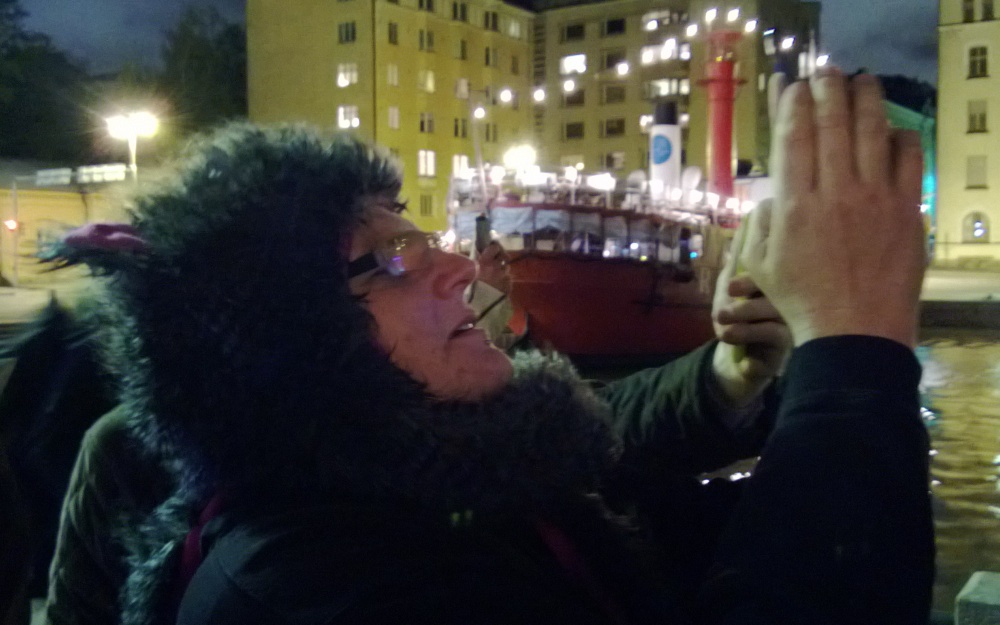You see, the concept of better camera phone photos in "low light" keeps being cited and we saw yesterday in Engadget's tests, that Nokia's concept of full optical image stabilisation (OIS) in the Lumia 920 produces superbly clear photos when the subject stays still. So a boat or collection of test objects - or, indeed, a floodlit building. What's less clear is how well the Lumia 920 will perform when faced with real world photos of people - these, after all, constitute over 90% of most normal people's low light photos on their phones.
The thing about people is that they move. Even if told to stay still because you're taking a photo, they still move. Facial expressions change, they wobble (slightly) on their feet, hands and arms move (especially if holding drinks!), and so on. The trick is not only to light the scene, it's not only to make sure there's no blur from your own holding of the camera phone, it's to freeze the moment, too. And this is where my concern lies.
Now, don't get me wrong, I'm quite impressed by the static subject samples seen so far from the Lumia 920, but I wanted to apply a little maths to a comparison between it and phones like the Nokia N8 and 808 PureView, both armed with zero stabilisation, zero back side illumination, but a full Xenon flash.
At the Lumia 920's launch, I noted:
- a "floating lens" optical image stabilization system for "much sharper photography in low-light situations".
- a F2.0 aperture
- BackSide Illuminated (BSI) 8.7 Megapixel sensor
- an improved camera interface
- the ability to record 1080p HD video
- a "next generation short pulse high power" LED flash, rated at twice the brightness of Nokia's previous brightest LED unit and with shorter duration

Leaving aside the not inconsiderable fact that the Nokia 808 and N8 have much larger sensors (and can thus process more detail and/or do so with lower digital noise), let's start with the usual rule of thumb that a phone-mounted Xenon flash is roughly ten times brighter than a standard LED arrangement but with a duration that's a hundred times shorter (which is why Xenon flash can freeze the moment).
Now, let's add in a few correcting factors. The larger aperture in the Lumia 920 (and other top 2012 camera phones like the HTC 8X) means that more light can be acquired in a short time period, so let's call this a factor of two better than a 2010 camera-equipped phone. The BSI sensor processes light more efficiently too, let's be generous and assign this another factor of two improvement. The Lumia 920's was specifically quoted as being twice the brightness of previous Nokia LED flashes, so that's a further factor of two. I'm tempted to assign another factor for the 'shorter duration', but a) we've been generous so far and b) I suspect that it's not more than a few percent shorter.
Overall though, the three factors of two ('2' cubed is eight, for the maths-challenged out there!) bring the illumination factor for the flash in the Lumia 920 up to the same order of magnitude as the Xenon flash in devices like the Nokia N8 and Nokia 808. This is an important levelling achievement.
However, the flash duration is still an issue. As I say, a few years ago, my own tests (e.g. the frozen [spinning] fan blade here) and calculations showed that Xenon was a hundred times faster than LED flash, of the order of 100 microseconds. No matter what you're trying to photograph in low light, be it people or kids or animals, there's little any of them can do in 100 microseconds to spoil your shot. I've tested the Xenon flash on various Nokia camera phones (N82, N8) and successfully frozen the pounding arms of band drummers, and of kids jumping in mid-air, in near total darkness. When trying to photograph friends and family indoors and at evening events, such flash heroics are more than sufficient to freeze the moment.
Now, the (roughly) eight fold improvement in light acquisition for devices like the Lumia 920 means that, for close-up subjects at least, the exposure can be reduced by a similar amount, i.e. there's (potentially) eight times less motion blur in your peskily moving subjects. Add that into the removal of motion blur caused by you moving the phone (because of OIS) and there's every likelihood that social photos taken on the Nokia Lumia 920 will be quite a bit better than in the previous generations of phone camera with LED flash.
The mathematician in me will still point to the fact that 100 is still roughly twelve times greater than 8, though - so Xenon-lit shots from the likes of the N8 and 808 will still be an order of magnitude sharper again.
I've done lots of Xenon rants over the years on AAS, but here's a typical example of the sort of thing Xenon flash can achieve in your life, courtesy of Jay's Halloween photo set from his Nokia N8:

Leaving aside the obvious question of how come we never get invited to this sort of party(!), the huge question is whether the likes of the Nokia Lumia 920 can get anywhere close to this level of quality/sharpness?
It was noticeable that in Myriam's tests yesterday, Nokia only encouraged here to snap static subjects. There were a few done of people under the same circumstances, for example this one, taken on another Lumia 920 of (a very well wrapped up!) Myriam taking test shots on the other 920:

I'd argue that, although reasonably exposed, details of face and hands have the typical blur of non-Xenon-lit camera phone shots. The Lumia 920's flash was turned off, but I don't think that would have made much difference in terms of failing to 'freeze' the moment.
Now, obviously, we're only talking about Lumia 920 prototypes here and I've never even held the device, but I think I can be fairly confident in stating that, while the Lumia 920 will produce stunningly good night photos of static subjects, it will, even with the improved LED flash, still not be able to get close to the frozen quality of photos under identical conditions from the 2007 Nokia N82, the 2009 Sony Ericsson Satio, the 2010 Nokia N8 and the 2012 Nokia 808 PureView.
The other obvious question is why do more manufacturers not put Xenon flash into their phones? The Lumia 920 is easily thick enough for the required (300V!) Xenon capacitor, though I'd agree that thinner phones like the HTC 8X might have an issue. The other reasons usually quoted are battery drain (each Xenon shot can draw as much as five or ten times the power as an LED equivalent) and the way Xenon can't double as a torch or video light.
I remain frustrated though - the only Windows Phone device to have 'Xenon' flash was the HTC 7 Mozart - and it was so badly implemented that it produced worse results than my LED-powered phones back in 2005. The only Android phone with Xenon was the Motorola Milestone XT720 and that was utterly crippled by being slower than a Nokia N97 covered in treacle.
So I return to my opening statement. I'll head out to any low light social event of Nokia's choosing - and I'll bring the 2007 Nokia N82. The Lumia 920 folk can bring along their 2012 prototypes and we'll shoot a load of shots around a few drinks, chat and general cavorting. And I bet the N82 nails 90% of the best photos.
In the meantime, you'll find me geekily sulking over my pint in the corner of the pub, cradling my N82, N8 and 808......
No hay comentarios:
Publicar un comentario